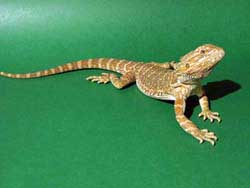These lizards, for lizards they are, make one of the best all around reptile pets that money can buy; or that you can catch if you are lucky enough to live in Australia where they are indigenous. Instead of chasing down and eating knights in armor, or dwarves and elves, these critters eat things like crickets, super-worms, leafy plants like red leaf lettuce, mustard greens and the like, and other vegetables like green beans, lima beans, cauliflower, broccoli, shredded carrots, corn, tomatoes, and some fruit (that is at least in captivity).
 These are a desert species so like their wild kin they like it hot. They need a basking spot under a heat lamp where the temperature will reach about 105 to 110 degrees Fahrenheit, and of course they need a cooler area in their enclosure down to the 80's during the day; the whole set up can get to the low seventies at night. Despite being a desert lizard, they do need water, at least a misting every other day so they can drink.
These are a desert species so like their wild kin they like it hot. They need a basking spot under a heat lamp where the temperature will reach about 105 to 110 degrees Fahrenheit, and of course they need a cooler area in their enclosure down to the 80's during the day; the whole set up can get to the low seventies at night. Despite being a desert lizard, they do need water, at least a misting every other day so they can drink.Their temperament is one of the best of the lizard species normally found available in the pet trade. They rarely, if ever, bite in defense, though sometimes bluff with gaping mouth if alarmed. They normally calm down and take very well to frequent handling. They are fairly easy to care for so long as you supply them with a large enough enclosure - about a minimum of a 35 gallon long tank for a sexed pair (don't keep males together they are extremely territorial with one another), a UV light source such as a florescent reptile bulb, a heat source (such as a ceramic heat emitter or incandescent bulb), a timer for the lights, a branch on which to bask, some stones or bricks on which to bask and keep their nails trimmed, play-sand or another suitable substrate, crickets, vegetable matter, and water. I would also highly recommend buying a book on how to care for them, and reading it in full before even seriously considering purchasing one or more. A good care sheet can be found on the Internet @ http://www.lihs.org/files/caresheets/sheet16.htm.
 I picked up a beautiful pair of these last week, the female is up above, the male to the left. I am hoping to either resell them in a quick turn around, or if not, then to breed them if I still have them in 7 to 8 months when adults. They are about 4 months old now. Since a female can produce up to 30 eggs in one clutch, I could make a nice little bit of spare change for my hobby if mine is very productive and all the eggs hatch. I won't count my bearded dragons until then though, that is until the eggs hatch; and I won't count the eggs until they are laid. That is a long way off if I keep them. For now, I am just going to enjoy them, and I figured I share their pics with you.
I picked up a beautiful pair of these last week, the female is up above, the male to the left. I am hoping to either resell them in a quick turn around, or if not, then to breed them if I still have them in 7 to 8 months when adults. They are about 4 months old now. Since a female can produce up to 30 eggs in one clutch, I could make a nice little bit of spare change for my hobby if mine is very productive and all the eggs hatch. I won't count my bearded dragons until then though, that is until the eggs hatch; and I won't count the eggs until they are laid. That is a long way off if I keep them. For now, I am just going to enjoy them, and I figured I share their pics with you.Oh yeah, one last thing - what's in a name. Bearded Dragons are so called because when excited they tend to puff up a bit and bluff, when they do so, a patch on their throat darkens and puffs out markedly. It looks very much like a beard, especially since there are lots of little pointy scales on the skin there, like stubble of a beard.
All the best,
Glenn B